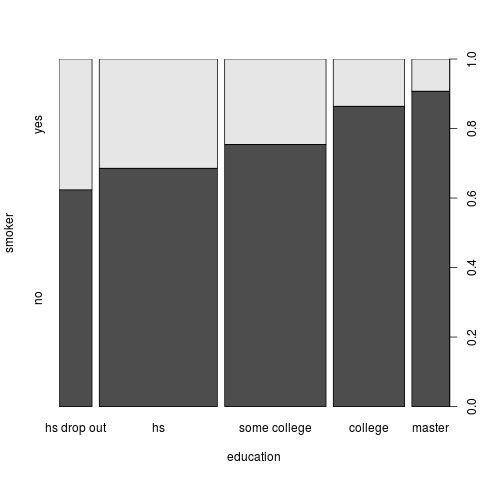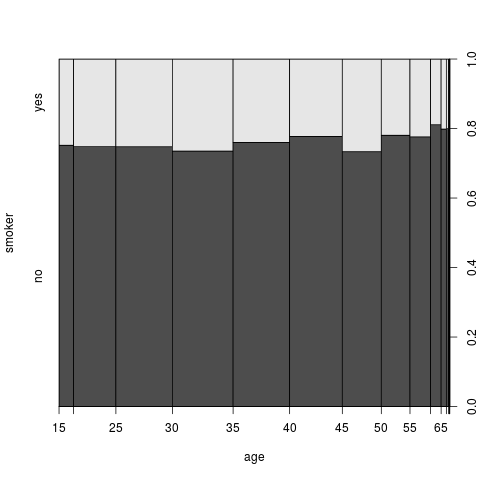Supported by Dr. Osamu Ogasawara and  providing providing  . . |
|
Last data update: 2014.03.03 |
Do Workplace Smoking Bans Reduce Smoking?DescriptionEstimation of the effect of workplace smoking bans on smoking of indoor workers. Usagedata("SmokeBan")
FormatA data frame containing 10,000 observations on 7 variables.
Details
SourceOnline complements to Stock and Watson (2007). http://wps.aw.com/aw_stock_ie_2/0,12040,3332253-,00.html ReferencesEvans, W. N., Farrelly, M.C., and Montgomery, E. (1999). Do Workplace Smoking Bans Reduce Smoking? American Economic Review, 89, 728–747. Stock, J.H. and Watson, M.W. (2007). Introduction to Econometrics, 2nd ed. Boston: Addison Wesley. See Also
Examples
data("SmokeBan")
## proportion of non-smokers increases with education
plot(smoker ~ education, data = SmokeBan)
## proportion of non-smokers constant over age
plot(smoker ~ age, data = SmokeBan)
Results
R version 3.3.1 (2016-06-21) -- "Bug in Your Hair"
Copyright (C) 2016 The R Foundation for Statistical Computing
Platform: x86_64-pc-linux-gnu (64-bit)
R is free software and comes with ABSOLUTELY NO WARRANTY.
You are welcome to redistribute it under certain conditions.
Type 'license()' or 'licence()' for distribution details.
R is a collaborative project with many contributors.
Type 'contributors()' for more information and
'citation()' on how to cite R or R packages in publications.
Type 'demo()' for some demos, 'help()' for on-line help, or
'help.start()' for an HTML browser interface to help.
Type 'q()' to quit R.
> library(AER)
Loading required package: car
Loading required package: lmtest
Loading required package: zoo
Attaching package: 'zoo'
The following objects are masked from 'package:base':
as.Date, as.Date.numeric
Loading required package: sandwich
Loading required package: survival
> png(filename="/home/ddbj/snapshot/RGM3/R_CC/result/AER/SmokeBan.Rd_%03d_medium.png", width=480, height=480)
> ### Name: SmokeBan
> ### Title: Do Workplace Smoking Bans Reduce Smoking?
> ### Aliases: SmokeBan
> ### Keywords: datasets
>
> ### ** Examples
>
> data("SmokeBan")
>
> ## proportion of non-smokers increases with education
> plot(smoker ~ education, data = SmokeBan)
>
> ## proportion of non-smokers constant over age
> plot(smoker ~ age, data = SmokeBan)
>
>
>
>
>
> dev.off()
null device
1
>
|

